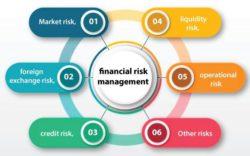Understanding Financial Risk In Crypto: Definitions And Examples

In the ever-evolving world of cryptocurrencies, investors are presented with unprecedented opportunities and risks. To navigate this digital financial landscape successfully, one must grasp the concept of financial risk in crypto. In this article, we’ll delve into the definitions of financial risk in crypto and provide real-world examples to help you make informed decisions when investing in cryptocurrencies.
What is Financial Risk in Crypto?
Financial risk in crypto refers to the potential loss of capital or investment value due to various factors specific to the cryptocurrency market. Unlike traditional financial assets, cryptocurrencies are highly volatile, decentralized, and influenced by a multitude of factors, making them susceptible to unique forms of risk. Let’s explore some of these risks and understand their implications.
1. Market Risk 📉
Market risk, also known as price risk, is the most apparent risk in the crypto space. Cryptocurrency prices can fluctuate dramatically in a short period. For example, Bitcoin, the pioneer cryptocurrency, has seen price swings ranging from thousands to tens of thousands of dollars in a matter of weeks. Investing without a thorough understanding of market dynamics can lead to substantial losses.
2. Regulatory Risk 📜
Cryptocurrencies operate in a regulatory gray area in many jurisdictions. Changes in government policies and regulations can significantly impact the crypto market. For instance, a government ban on cryptocurrency trading or increased taxation can lead to sudden market crashes. Staying informed about regulatory developments is crucial for managing this risk.
3. Security Risk 🔒
Security breaches and hacks are prevalent in the crypto space. Exchange platforms and wallets are susceptible to cyberattacks, resulting in the loss of user funds. It’s essential to choose reputable exchanges and implement robust security measures, such as two-factor authentication (2FA), to mitigate security risks.
4. Technology Risk 💻
Cryptocurrencies rely on blockchain technology, which is continuously evolving. Forks, software bugs, or vulnerabilities in the underlying technology can disrupt the functionality of a cryptocurrency. Understanding the technology behind a cryptocurrency and monitoring updates is vital to avoid technical risks.
5. Liquidity Risk 💱
Liquidity risk refers to the ease of buying or selling a cryptocurrency without significantly affecting its price. Some cryptocurrencies have low trading volumes, making it challenging to execute large orders without causing price slippage. Traders and investors should be cautious when dealing with illiquid assets.
Also, read – Becoming A Cryptocurrency Compliance Analyst: Navigating The Regulatory Landscape
What are the types of financial risk in crypto?
Financial risk in the world of cryptocurrencies encompasses various factors that can potentially lead to losses or negative financial outcomes for investors and participants in the crypto market. Understanding these types of financial risk is crucial for anyone looking to engage with cryptocurrencies. Here are the primary types of financial risk in crypto:
- Market Risk (Price Risk):
- Definition: Market risk, often referred to as price risk, is the most apparent and fundamental risk in the crypto space. It represents the risk of losing money due to fluctuations in the prices of cryptocurrencies.
- Factors: Cryptocurrency prices can be highly volatile, with significant price swings occurring over short periods. Factors contributing to market risk include market sentiment, supply and demand dynamics, news events, and speculative trading.
- Example: Bitcoin, the most well-known cryptocurrency, has experienced price fluctuations ranging from thousands to tens of thousands of dollars in a matter of weeks.
- Regulatory Risk:
- Definition: Regulatory risk pertains to the risk associated with changes in government policies, laws, and regulations related to cryptocurrencies. It can include bans, restrictions, taxation, or unfavorable regulatory actions.
- Factors: Different countries have varying approaches to regulating cryptocurrencies, and regulatory environments can change rapidly. News of government crackdowns or unfavorable regulations can have a significant impact on the crypto market.
- Example: China’s ban on cryptocurrency trading in 2017 led to a notable drop in Bitcoin’s price and disrupted the global crypto market.
- Security Risk:
- Definition: Security risk involves the threat of hacking, fraud, or other cybersecurity breaches that can result in the loss of cryptocurrencies stored in wallets or on exchange platforms.
- Factors: Cryptocurrencies are stored in digital wallets, and exchanges serve as intermediaries for trading. Both wallets and exchanges are susceptible to cyberattacks, phishing attempts, and security vulnerabilities.
- Example: The Mt. Gox exchange hack in 2014 resulted in the loss of approximately 850,000 Bitcoins due to security vulnerabilities in the platform.
- Technology Risk:
- Definition: Technology risk relates to vulnerabilities, bugs, or issues in the underlying blockchain technology or the cryptocurrency’s code. These issues can disrupt the functionality of a cryptocurrency.
- Factors: Cryptocurrencies rely on blockchain technology, which is constantly evolving. Forks, software bugs, or vulnerabilities can lead to network disruptions, hard forks, or even the creation of competing cryptocurrencies.
- Example: Ethereum’s DAO hack in 2016 exposed a vulnerability in smart contracts, leading to a contentious hard fork to reverse the damage, highlighting technology risk and community response.
- Liquidity Risk:
- Definition: Liquidity risk refers to the difficulty of buying or selling a cryptocurrency without significantly affecting its price. Some cryptocurrencies have low trading volumes, making it challenging to execute large orders without causing price slippage.
- Factors: Cryptocurrencies with low trading volumes may suffer from illiquidity, making it harder to exit positions quickly or at desired prices.
- Example: Low-cap altcoins often have liquidity issues, where selling a substantial amount can lead to a significant price drop.
- Counterparty Risk:
- Definition: Counterparty risk is the risk associated with the parties you engage with in the crypto ecosystem, such as exchanges, lending platforms, and counterparties in over-the-counter (OTC) trades.
- Factors: Trusting third-party entities in the crypto space can be risky. Exchanges may become insolvent, lending platforms can default, and OTC trades may involve unscrupulous counterparties.
- Example: The collapse of the QuadrigaCX exchange in 2019 left users unable to access their funds, highlighting counterparty risk.

Understanding and managing these types of financial risk in crypto is essential for responsible participation in the cryptocurrency market. Diversification, risk assessment, due diligence, and staying informed about the crypto industry’s developments and regulations can help mitigate these risks.
“Crypto” companies are playing the rehypothecation game, creating unnecessary financial risk.
Remember that Bitcoin was literally created in response to bailouts.
— Stephan Livera (@stephanlivera) June 22, 2022
Real-World Examples
To illustrate these risks, let’s look at some real-world examples:
- In 2017, the price of Bitcoin skyrocketed to nearly $20,000 but subsequently crashed to around $3,000 in 2018, highlighting the extreme market volatility.
- China’s ban on cryptocurrency trading in 2017 caused a significant drop in Bitcoin’s price, showcasing the impact of regulatory risk.
- The infamous Mt. Gox exchange hack in 2014 resulted in the loss of approximately 850,000 Bitcoins due to security vulnerabilities.
- Ethereum’s DAO hack in 2016 led to a contentious hard fork to reverse the damage, highlighting technology risk and the community’s response.
- Low-cap altcoins often suffer from liquidity issues, where selling a substantial amount can lead to a significant price drop.
Conclusion
Understanding financial risk in crypto is paramount for anyone considering investing in cryptocurrencies. It involves assessing market volatility, staying informed about regulatory changes, securing your assets, monitoring technology developments, and being cautious of liquidity issues. By comprehending these risks and learning from real-world examples, you can make more informed decisions in the dynamic world of cryptocurrency investing. Remember, while the potential for high returns exists, so does the potential for substantial losses. Always do your research and consider your risk tolerance before diving into the crypto market. 💡🚀




























































